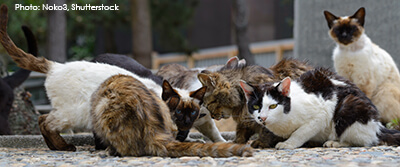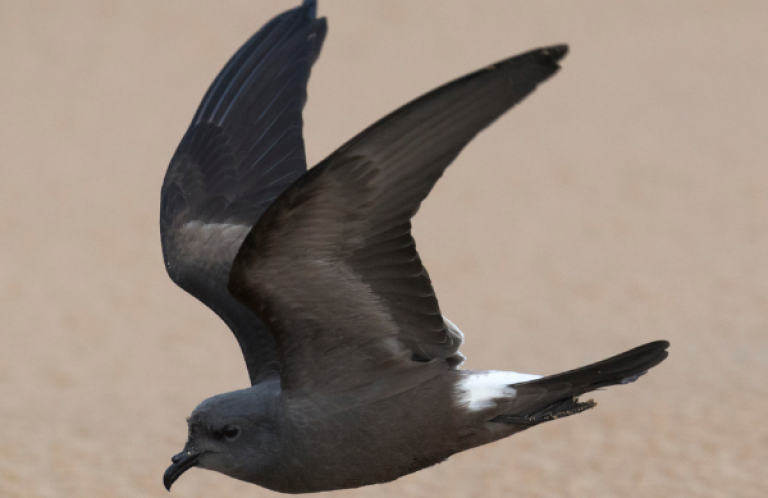New Study: Almost 90 Percent of People Surveyed Want Reduction in Feral Cat Numbers in Hawai'i
 |
|---|
(Washington, D.C., January 30, 2014)
Eighty-seven percent of respondents to a recent study in Hawai'i want to see a decrease in the number of feral cats in the Hawaiian Islands. The survey, which was completed by more than 1,500 people, was designed to clarify beliefs and desires among stakeholders regarding feral cat abundance and management.
Published online by the journal Conservation Biology, the study was authored by Cheryl A. Lohr and Christopher A. Lepczyk of the Department of Natural Resources and Environmental Management, University of Hawai'i at Manoa. The survey was disseminated to 5,407 people from six stakeholder groups: animal welfare activists, hunters, conservation professionals, agriculturalists, native Hawaiians, and randomly selected state residents. Approximately 46 percent of pre-identified stakeholders and 20 percent of random residents responded to the survey, with 1,510 surveys returned.
All stakeholder groups, including animal welfare activists, indicated that they would like to see a decrease in the abundance of feral cats in the Hawaiian Islands, with an average of 86.9 percent favoring a decrease. Even among those who feed feral cats, 67 percent would like to see the number of feral cats reduced, while 27 percent favored no change, and none favored an increase. In addition, of seven feral cat management techniques outlined, including lethal options, "trap, neuter and release," or TNR, was the least-preferred by survey respondents.
"The value of our work is that it provides a robust sample of attitudes from Hawai'i's stakeholders, which complements the basic science already conducted on feral cats and finds strong commonalities about the problem and possible management solutions," said co-author Christopher A. Lepczyk.
"Two take-away messages stand out," said Grant Sizemore, Cats Indoors Program Officer for American Bird Conservancy (ABC). "An overwhelming majority of people responding to the study support efforts to seriously curb feral cat populations, and TNR is the least popular strategy to make those critical reductions."
This finding surprised the authors, who had hypothesized that given the large number of cat colonies in Hawai'i—combined with the number of legislative bills and resolutions submitted that support TNR as an appropriate method of cat management—a large segment of society would support the presence of feral cats in Hawai'i. The results suggest just the opposite, said Sizemore: "TNR not only has failed to control feral cat populations, it is not even considered an acceptable approach by the vast majority of stakeholders."
The issue of feral cat management is especially pressing in Hawai'i. While Hawai'i is a place that conjures up images of a tropical paradise, the state claims the unfortunate title of "bird extinction capital of the world." Non-native cats have certainly played a role in these extinctions, as they are known predators of many of Hawaii's most imperiled bird species, including Hawaiian Petrel, Newell's Shearwater, and Palila, among others.
"There is no place else on earth that has witnessed the levels of bird extinctions that have occurred in Hawai'i," said George Wallace, Vice President for Oceans and Islands for ABC. "Since the arrival of Europeans to the Hawaiian Islands, 71 endemic bird species have become extinct out of a total of 113 that existed just prior to human colonization. Of the remaining 42, 32 are federally listed, and 10 of those have not even been seen for at least 40 years."
Respondents were generally aware of at least one of the potential risks associated with the presence of feral cats. On average, 73.5 percent of respondents stated that feral cats pose a risk to native fauna. However, far fewer indicated that they believe that cats present risks in the form of contaminated soil or water, impacted human health or safety, and damaged human property or income.
According to Dr. George Fenwick, a Johns Hopkins-educated pathobiologist who is also President of American Bird Conservancy, "The number of domestic cats in the U.S. has tripled in the last 40 years. Both owned and un-owned cats have increased to as many as 188 million. Not only do studies show that these cats are killing 2.4 billion birds and 12.3 billion mammals each year, they are also contaminating our beaches, parks, oceans, rivers, and residential areas with a dangerous parasite, Toxoplasma gondii, that will remain viable for long periods of time. Hundreds of millions of infectious eggs may be deposited in these areas by a single infected cat."
The link among cats, T. gondii, and humans is documented in many studies. According to one, up to 74 percent of cats in the United States will become infected with T. gondii during their lifetime. Another, a study from scientists at the Stanley Medical Research Institute and Johns Hopkins University, stated: " … because cats are now so ubiquitous in the environment, one may become infected [with T. gondii] by neighboring cats which defecate in one's garden or play area, or by playing in public areas such as parks or school grounds."
While a T. gondii infection may not show symptoms, dormant cysts in the human brain or elsewhere may still cause lasting effects. T. gondii infections are potentially fatal to immuno-compromised people and may cause spontaneous miscarriage in pregnant women or birth defects. Some preliminary studies suggest that chronic infection may be linked to schizophrenia or suicidal behavior.
The connection with cats–the sole, definitive host of this parasite–is unquestionable. One study found that almost 80 percent of mothers of congenitally infected infants in the sample contracted their infections as a result of environmental contamination from cat feces.
"Our civic leaders are either ignoring or embracing practices that foster burgeoning populations of feral cats," Fenwick said. "The consequences will be felt for decades, if not longer, by both the suffering cats and people. Those officials continue to accept the emotionally laden arguments of cat advocates, suggesting that feral cats pose no harm to the environment or to their communities—in contrast to a mountain of peer-reviewed science saying just the opposite."
ABC has been calling attention to issues associated with exploding feral cat populations in the U.S. since 1994. Recent studies ringing alarms on the feral cat issue have been authored by scientists from the Centers for Disease Control and Prevention, the Smithsonian Migratory Bird Center, and the U.S. Fish and Wildlife Service.


















































